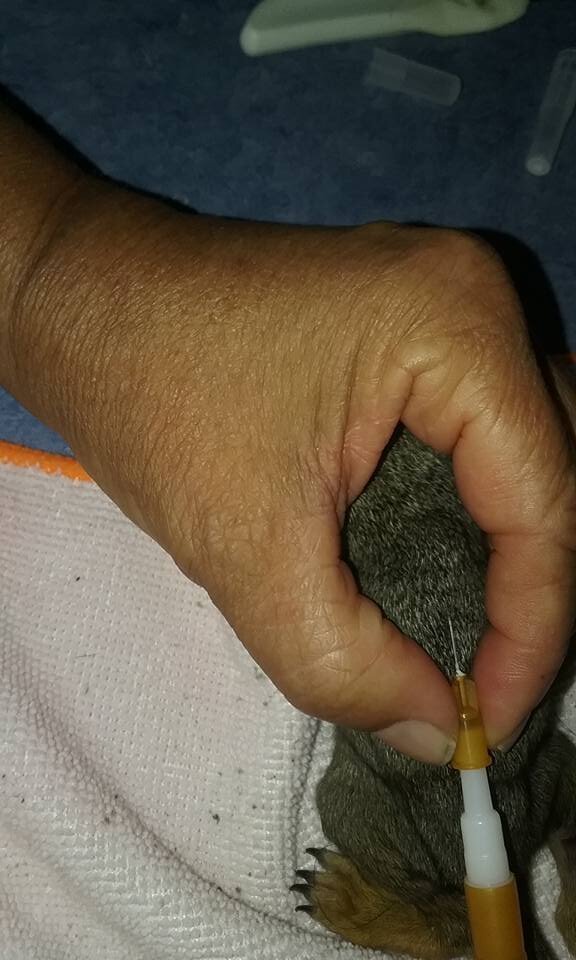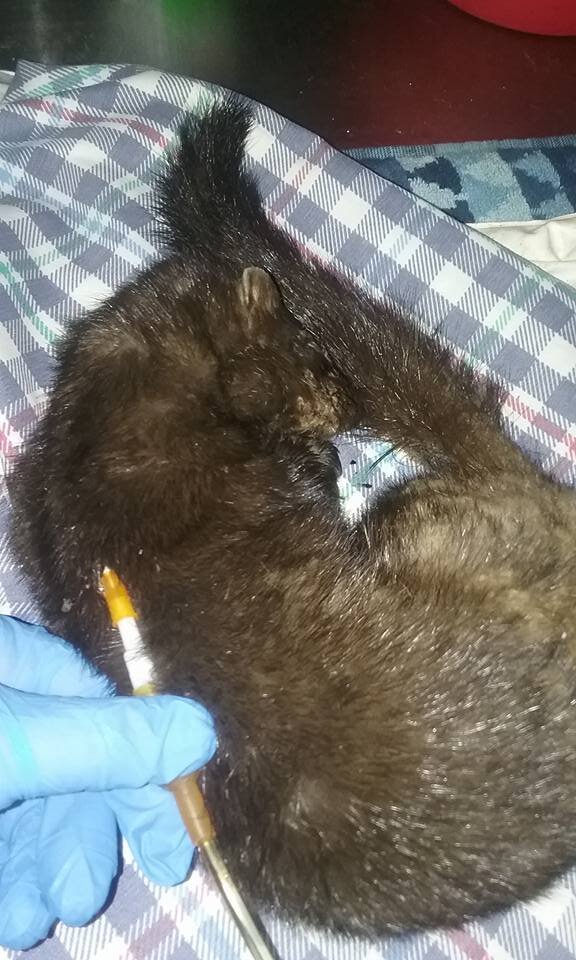One of the most lifesaving skills you can have in wildlife rehabilitation is the ability to assess hydration levels and give fluids. Dehydration will kill an animal faster than a lack of food.
The process of rehydration begins after warming the baby for thirty to sixty minutes.
This article is an introduction to determine what fluids to use and how to administer and pertains mainly to mammals. As always if you have questions consult with your veterinarian.
If you are interested in becoming a licensed wildlife rehabilitator you can read my article to learn how.
WHAT IS DEHYDRATION
The basic answer is that dehydration happens because more water and fluids leave the body than enter it. Simple.
The animal’s body is 75% water. A neonate may be as much as 90% water.
So losing water that is not replenished is a big deal.
CAUSES OF DEHYDRATION
Many things can cause dehydration in an animal. Things such as hot weather, no water source, diarrhea from illness, or blood loss.
The most common source of dehydration that we see in babies is from lack of milk. Whether mom is dead, sick, or injured the baby is unable to nurse.
SYMPTOMS OF DEHYDRATION
You can diagnose dehydration by looking at an animal. Some common symptoms are:
poor skin elasticity
shrunken appearance especially around eyes
lethargy
dry mucus membranes
fast but weak pulse
In addition, animals can become dehydrated when they are under our care. Always monitor your baby’s intake and outtake. Yes, be obsessed with how much they poop and pee! Some center reasons for dehydration are:
Medicine and Illness
Formula is not the right consistency
Feedings are not on the right schedule for age and species
Lack of water source
This video talks about why we need to give fluids, some of the different methods, and supplies you need to have on hand. Check out my YouTube channel.
WHAT IS REHYDRATION?
Rehydration is giving the animal fluids so that you can restore the lost water.
Fluid therapy is complex and will vary with species and weight of the animal in your care.
NEVER FEED BABY UNTIL AFTER REHYDRATION
This is very important. Baby animals should never be offered food until after they are rehydrated. Food, and formula is food, can actually cause their system to shut down.
Many times finders inadvertently kill baby animals because they automatically want to feed them. If you are a finder call a wildlife rehabilitator or your veterinarian to access what the baby needs.
Even an animal that seems perfectly hydrated should receive fluids to help them transition to new foods. I give everything fluids to start with.
For those of you that have taken the Basic Class with IWRC, you may remember the conversion charts.
When figuring the amount of fluids needed you will consider that fluids are needed for daily body maintenance; for rehydration of lost fluids, and the replacement of fluids lost to excretion, sweating, etc.
Check out my latest book in my wildlife rehabilitation series! SQUIRRELS!!
Anne Fowler BVSC, in her presentation for the National Wildlife rehabilitation conference, states that she assumes a 10% loss of fluids as a general guideline but the animal may have more.
The standard maintenance requirement of most species is approximately 50-60 ml/kg/day, or 5% of body weight.
Dr. Ann Fowler states that It is typical that most animals come into your facility with at least a 10% dehydration. This means the total volume of fluid that we give to the baby includes both the “ongoing maintenance requirements and the replacement required from dehydration”.
So in the following example, we assume 50% of this deficit is replaced in the first twenty-four hours and the remainder over the following two days.
Day 1: maintenance (5%) + rehydration (5%) = 10% of body weight
Day 2: maintenance (5%) + rehydration (2.5%) = 7.5% of body weight
Day 3: maintenance (5%) + rehydration (2.5%) = 7.5% of body weight
Fluids are easy to metabolize in the body, can reduce the effects of shock, and helps the body transition.
HOW DO YOU GIVE FLUIDS?
There are several methods you can use to rehydrate. The method you use will depend on the health of the animal and the type of fluid you are using.
ORALLY
This method works well if the baby is conscious and alert. Using a syringe and a nipple you can give warm fluids via the mouth.
Proper measurements and care when regarding the amount should be taken. You can give to much at once and harm the digestive system.
I love the Miracle Nipples. They are a bit pricey but worth the cost.
This method is less stressful on the animal as it’s natural for them to take in liquids via the mouth. The fluids will enter the digestive system and get distributed in the body quickly.
Don’t use the oral method if the animal is unconscious, has neurological symptoms, or is having seizures.
Tube Feeding, or gavage, is another oral method. Tube feeding is a skill that needs to be learned from a vet as it can cause death if done improperly. Some animals such as opossums are good candidates for tube feeding.
Some good oral fluids are Pedialyte and Gatorade. Both are easily available. Pedialyte is more expensive but can be used in all levels of dehydration. You should get unflavored Pedialyte as it has less sugar.
Gatorade and other sports drinks are good for mild dehydration. I will often mix Gatorade and Pedialyte. This cuts down on the sugar but still flavors the Pedialyte a bit so that they eagerly drink it up.
Lactated Ringers Solutions or Saline solutions can also be given orally. LRS requires a prescription or to be purchased from your vet.
SUBCUTANEOUS
Subcutaneous means under the skin and is often referred to as SubQ. A needle is inserted just under the skin and the fluid is inserted via a syringe or a drip line. This is an easy technique to learn from a veterinarian or experienced wildlife rehabilitator.
If an animal can not or will not take fluids orally then the subcutaneous method is the right option. This method is not quite as fast-acting because the fluids need to be absorbed by the body.
In a serious dehydration case, you may choose to use both methods to have maximum benefits.
Lactated Ringers is the brand most often used in veterinary and medical offices. It is an isotonic solution which means it will not draw fluid from the cells via osmosis.
IV solutions require a prescription. I typically buy the Ringers from my vet. You can also purchase from Chewy or KVSupply with a prescription from your vet.
It’s important to keep in mind that this process can cause the animal discomfort and even pain. Their skin is dry and tight and by giving sub Q fluids we are stretching the skin.
Always use warm but never hot fluids. Never microwave fluids as it can cause pockets of high heat within the fluids.
STEPS TO REHYDRATING A BABY
Give the baby a quick exam and access their medical needs.
Warm the baby
Determine the level of dehydration and decide the method of rehydration
Weigh the baby and determine the amount
Warm the fluids to body temperature
Give initial fluids
Depending on age and species you will continue to give fluids every two to three hours for the first 24 hours.
Continue to assess baby vitals and monitor for improvement
SWITCHING FROM FLUIDS TO FORMULA
After 24 hours of fluids, you can start to make a slow switch to formula. This process is slow to allow the baby to adjust to a food source.
Also, don’t forget to keep giving replacement fluids until the baby is properly hydrated. You can still continue SubQ fluids while switching to formula. You can also choose to add the replacement amount of fluids to the feeding schedule.
When switching to formula start slowly. For the first two feedings use 1/4 formula and 3/4 fluids. Feedings three and four will get 1/2 formula and 1/2 fluids. Feedings five and six will receive 3/4 formula and 1/4 rehydration fluids. After that switch to full strength formula.
Observe the baby to make sure they are properly digesting each mixture and having normal toileting before moving on to the next level.
TAKE AWAY
Giving fluids will be a life-saving skill and a valuable one in your career as a licensed wildlife rehabilitation specialist.
Author, Ame Vanorio, is a licensed wildlife rehabilitator. She is the director of Fox Run Environmental Education Center where we help people learn about living environmentally sustainable lives.



